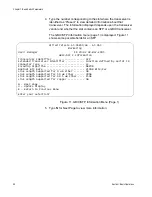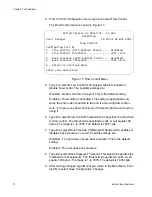
AT-S63 Management Software Menus User’s Guide
Section I: Basic Operations
69
Configuring Head of Line Blocking
Head of line (HOL) blocking is a problem that occurs when a port on a
switch becomes oversubscribed. An oversubscribed port is receiving more
packets from other switch ports than it can transmit in a timely manner.
An oversubscribed port can prevent other ports from forwarding packets to
each other because ingress packets on a port are buffered in a First In,
First Out (FIFO) manner. If the head of an ingress queue consists of a
packet destined for an oversubscribed port, the ingress queue is not able
to forward any of its other packets to the egress queues of other ports.
A simplified version of the problem is illustrated in Figure 16. It shows four
ports on a switch. Port D is receiving packets from two ports—50% of the
ingress traffic on port A and 100% of the ingress traffic on port B. Not only
is port A unable to forward packets to port D because the latter’s egress
queues are filled with packets from port B, but it is also unable to forward
traffic to port C because its ingress queue has frames destined to port D
that it is unable to forward.
Figure 16. Head of Line Blocking
The HOL Limit parameter can help prevent this problem from occurring.
This parameter sets a threshold on the utilization of a port’s egress queue.
When the threshold for a port is exceeded, the switch signals other ports to
discard packets to the oversubscribed port.
For example, referring to the figure above, when the utilization of the
storage capacity of port D exceeds the threshold, the switch signals the
Port A
C C C C D D D D
Ingress Queue
Port B
D D D D D D D D
Ingress Queue
Port C
Egress Queue
Port D
D D D D D D D D
Engress Queue
100%
50%
50%
Summary of Contents for AT-9400
Page 16: ...Figures 16 ...
Page 18: ...Tables 18 ...
Page 28: ...Preface 28 ...
Page 30: ...30 Section I Basic Operations ...
Page 60: ...Chapter 1 Basic Switch Parameters 60 Section I Basic Operations ...
Page 64: ...Chapter 2 Port Parameters 64 Section I Basic Operations Port Type The port type ...
Page 84: ...Chapter 2 Port Parameters 84 Section I Basic Operations ...
Page 124: ...Chapter 6 Static Port Trunks 124 Section I Basic Operations ...
Page 144: ...144 Section II Advanced Operations ...
Page 196: ...Chapter 10 File Downloads and Uploads 196 Section II Advanced Operations ...
Page 218: ...Chapter 11 Event Logs and the Syslog Client 218 Section II Advanced Operations ...
Page 242: ...Chapter 13 Access Control Lists 242 Section II Advanced Operations ...
Page 294: ...294 Section III IGMP Snooping MLD Snooping and RRP Snooping ...
Page 314: ...Chapter 19 MLD Snooping 314 Section III IGMP Snooping MLD Snooping and RRP Snooping ...
Page 318: ...318 Section IV SNMPv3 ...
Page 416: ...Chapter 21 SNMPv3 416 Section IV SNMPv3 ...
Page 418: ...418 Section V Spanning Tree Protocols ...
Page 470: ...470 Section VI Virtual LANs ...
Page 520: ...Chapter 26 Multiple VLAN Modes 520 Section VI Virtual LANs ...
Page 532: ...Chapter 27 Protected Ports VLANs 532 Section VI Virtual LANs ...
Page 546: ...546 Section VII Internet Protocol Routing ...
Page 560: ...560 Section VIII Port Security ...
Page 568: ...Chapter 30 MAC Address based Port Security 568 Section VIII Port Security ...
Page 586: ...Chapter 31 802 1x Port based Network Access Control 586 Section VIII Port Security ...
Page 588: ...588 Section IX Management Security ...
Page 610: ...Chapter 33 Encryption Keys 610 Section IX Management Security ...
Page 650: ...Chapter 36 TACACS and RADIUS Protocols 650 Section IX Management Security ...
Page 660: ...Chapter 37 Management Access Control List 660 Section IX Management Security ...
Page 668: ...Index 668 ...






























